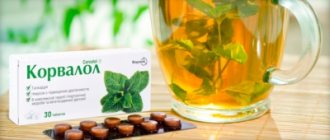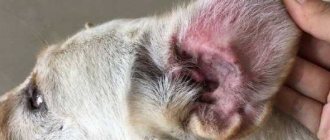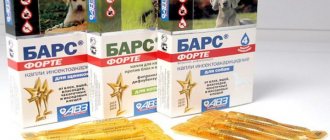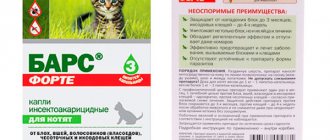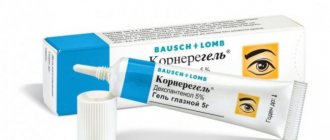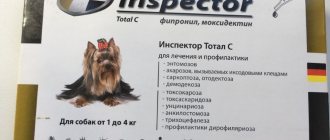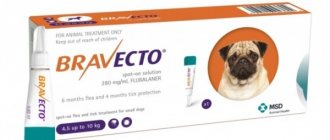Ear drops
The active substances are anandin and the antimicrobial agent gramicidin C. The medicine is packaged in bottles of 5-10 ml.
The cost of a 5 ml bottle in November 2021 is 75 rubles.
For acute or chronic otitis of bacterial etiology, 2-3 drops are instilled into the diseased and healthy ear 2-3 times a day for 4-7 days in a row. However, most often, otitis media is caused by parasitic mites Otodectes. Therefore, manufacturers have developed the drug Anandin Plus, which, in addition to the immunomodulator and antibiotic, contains the acaricidal agent permethrin.
The cost of a 5 ml bottle in November 2021 is 80 rubles.
Before using the drops, the ear canal is cleaned of wax, crusts and exudate. Apply 3-5 drops to each ear once a day for 3-7 days in a row. The effectiveness of treatment is confirmed by microscopy of scrapings from the inner surface of the auricle.
Instructions for use
Anandin preparations are easy to use; no prior special preparation is required. When using the ointment, you do not have to cut the hair on the affected area and remove dead particles of the epidermis.
| Product release form | How to use | Duration of therapy |
| Ointment | Apply a thin layer of the product to the wound, gently treat the skin around it. Carry out the procedure 1-3 times a day; before re-application, remove any remaining drug with an antiseptic or saline solution. | 5–7 days. |
| Solution for injections | The drug is injected intramuscularly, dosage – 0.2 ml/kg. | In mild forms of the disease – 3 days, in particularly severe cases – 6 days. |
| Drops for eye treatment | 2-3 drops under the lower eyelid in the morning and evening. | The medicine is used for 5 days; in case of severe illnesses, as prescribed by the veterinarian, the course is extended to 2 weeks. |
| Nasal drops | 3-4 drops in each nostril, three times a day. | For 5–7 days. |
| Ear drops | 3-5 drops, depending on the weight of the animal, every 8 hours. It is imperative to treat the diseased and healthy ear at the same time. | 5–7 days; you cannot interrupt the course ahead of schedule, even if your pet’s well-being has improved significantly. |
For the treatment of viral infections in animals, Anandin and Maxidin are often prescribed simultaneously - the first drug destroys pathogenic microorganisms, the second helps strengthen the pet's immunity and speedy recovery.
Contraindications and side effects
The drug Anandin is well tolerated by dogs of all breeds, regardless of age and the presence of chronic diseases; negative reactions in the form of itching and redness of the skin occur mainly in pets with hypersensitivity to the active ingredients of the drug. Active substances do not accumulate in the body and are completely excreted in the urine.
The main contraindications are the dog’s allergy to the medicine, the pet’s pregnancy, kidney failure. Ear drops should not be used if there is a suspicion of damage to the integrity of the eardrum.
When using Anandin products, it is necessary to protect the animal from exposure to direct sunlight.
Storage conditions and price
The medicine should be stored away from children, animals, food at a temperature of 0–25 degrees, and protected from sunlight. The shelf life of the drops and solution is 24 months, the ointment is 18 months, after opening the liquid forms of the drug must be used within 4 weeks.
The average price of the drug is 75–150 rubles.
Anandin is a good and affordable antiviral drug for treating animals; it has a minimal number of contraindications; you can buy it at any specialized pharmacy or clinic.
Symptoms and signs of a runny nose
In dogs, rhinitis can manifest itself in chronic and acute forms. Chronic rhinitis is accompanied by constant nasal discharge, which cannot be completely eliminated.
Acute form of rhinitis
Symptoms of a runny nose in dogs are somewhat similar to human manifestations of the disease. So, with rhinitis, the animal begins to sneeze frequently, lick its nose and rub it with its paws.
As the disease progresses, liquid mucous discharge appears in the nasal cavity and sinuses, which then thickens. Therefore, breathing is difficult. Sometimes there is redness of the mucous membranes, shortness of breath, thick purulent discharge, and lack of appetite.
Thus, the following symptoms are characteristic of a runny nose:
- discharge from the eyes and nose;
- swelling of the nasal passages;
- sneezing and watery eyes;
- weakening of sense of smell;
- snoring, snoring during sleep;
- constant licking of the nose;
- the appearance of painful crusts in the nose;
- breathing problems;
- inflammation of the eyes and ears;
- depressed state;
- elevated body temperature (not always).
The acute form of rhinitis lasts 4-7 days.
Reviews from veterinarians
Marina, veterinarian with 10 years of experience:
“Anandin is a universal drug from a domestic manufacturer. Available in different forms, this is undoubtedly an advantage for a veterinarian. It is inexpensive and sold in all veterinary pharmacies. Among the disadvantages, it is worth noting that the injections are painful, and the drops often cause allergic reactions. Or I just came across sensitive animals.”
Vadim, veterinarian at a Moscow clinic:
“I have been using the medication in my practice for a long time. Because of the pain, I don’t prescribe injections; among immunostimulants, I give preference to Imunofan. But I often prescribe ear and eye drops. There are cases when the effectiveness of the product leaves much to be desired, but overall the drug is good.”
Source
Dose calculation and correct use
The appropriateness of using Anandin, regardless of its pharmacological type, is determined by the doctor. He will prescribe a dosage depending on the disease, its severity and neglect.
- Thus, the drop form is used to treat conjunctivitis, rhinitis, sinusitis, 2-4 drops into the conjunctival sac or nasal passage 2-3 times a day. The duration of treatment continues until the pronounced symptoms of the pathology are eliminated. It usually takes 5-14 days.
- A solution for the treatment of ear diseases (otitis media, mites, etc.) is applied only after cleansing the diseased auricle (scabs, pus, crusts are removed). 3 drops of medicinal liquid are dripped into the ear canal and a light massage is performed at the base of the hearing organ. Manipulations are carried out 2 times a day. Depending on the condition, the duration of treatment can be from 7 to 14 days.
- In cases of serious viral infection, it is optimal to prescribe injections with Anandin. For 1 kg of animal weight, 20 mg of the product is taken. The injection is given once a day, intramuscularly, for 3-6 days. For the prevention of immunodeficiency and regressive conditions, the dosage is calculated at 5-10 mg per 1 kg. The therapeutic effect begins half an hour after administration.
- The ointment is used for skin dermatitis caused by infection. Apply directly to the affected area, covering healthy areas of skin up to 1 cm, and rub in gently. Treatment should be carried out 2-3 times a day over a course of 4-5 days. Use a cervical collar to prevent the animal from licking the ointment.
Anandin eye and intranasal drops for dogs and cats 7 ml
Composition and pharmacological properties.
Anandin eye drops and intranasal drops in 1 ml contain glucaminopropylcarbacridone (anandin) - 20 mg. Used in complex therapy of conjunctivitis and rhinitis of various etiologies in dogs and cats.
Glucaminopropylcarbacridone (anandine) belongs to the group of synthetic low-molecular-weight cytokine inducers, has anti-inflammatory and wound-healing effects, stimulates the production of endogenous interferon, increases the functional activity of T-lymphocytes and macrophages, and activates the production of anti-inflammatory cytokines.
Indications for use.
Anandin eye drops and intranasal drops are used in the complex therapy of conjunctivitis and rhinitis of various etiologies in dogs and cats.
Contraindications.
A contraindication to the use of the drug is the increased individual sensitivity of the animal to the components included in the drug.
Doses and order of application.
For conjunctivitis, the drug is instilled in 2-3 drops behind the lower eyelid twice a day, for rhinitis - 2-4 drops in each nasal passage two to three times a day. Treatment is carried out until the animal recovers, but not more than 14 days. The drops are compatible with other medications and feed additives. Avoid skipping the next dose of the drug, as this may lead to a decrease in therapeutic activity. If one dose is missed, the use of the drug is resumed at the same dose and according to the same regimen.
Side effects.
Side effects and complications when using the drug in accordance with the instructions, as a rule, are not observed.
In case of increased individual sensitivity to the active components of the drug or an overdose, it should be washed off with water and detergent and the animal should be prescribed antihistamines and symptomatic drugs.
Special studies on pregnant and lactating animals have not been conducted. The possibility of using Anandin eye drops and intranasal drops for females during pregnancy and feeding the offspring is determined by the attending physician based on an assessment of the ratio of benefits to the possible risk of using the drug.
Storage.
The shelf life of the drug, subject to storage conditions, is 2 years from the date of production. Store the medicinal product in the manufacturer's sealed packaging in a place protected from direct sunlight, separately from food and feed, at a temperature of 0 °C to 25 °C.
Release forms.
“Anandin eye and intranasal drops” are produced in polymer dropper bottles, sealed with screw-on polymer caps with first opening control, volume 7 ml.
Operating principle
In all dosage forms of Anandin, the active component is a substance called glucaminopropylcarbacridone. The substance has pronounced immunostimulating properties. The principle of its action is to stimulate interferon, a protein that is produced in response to the invasion of viruses into the body. In addition, the active substance stimulates the synthesis of antibodies.
The drug has antiviral and anti-inflammatory effects. It has a wound-healing effect, as it stimulates regeneration processes. The main feature of the drug is that it is able to eliminate the cause of the disease and relieve symptoms. If you follow the instructions for use, Anandin is considered completely safe for dogs, although it has some restrictions on use.
Injection
In addition to glucaminopropylcarbacridone, the composition includes water for injection and methylene blue. The medicinal liquid has a green color and a specific odor, but it is weakly expressed. The solution is packaged in dark glass ampoules. The capacity of each ampoule is 2 ml.
When and how to use
According to the instructions, Anandin is prescribed to dogs for infectious diseases:
- with plague of carnivores;
- with parvovirus enteritis;
- for pathologies caused by coronavirus;
- for viral hepatitis, etc.
For infections, it is combined with other medications. The medicine is also used to treat inflammatory processes caused by bacteria against the background of viral diseases. An immunostimulant is often prescribed after surgery or severe injuries to speed up rehabilitation, wound healing and restore the functionality of individual organs and systems.
Typically, the use of Anandin is combined with antibiotics, serums, sulfonamides, and hormones. Injections are given intramuscularly. Regardless of age, the dosage is 0.2 ml per kilogram of the pet’s weight. Injections are given once a day for 3 days. Sometimes the duration of treatment is extended to 5-6 days if the disease is in a severe stage.
Note! The injection solution cannot be used if the animal has renal failure. The active component of the medicine is excreted from the pet’s body by the kidneys, and diseased organs simply cannot cope with this task.
Owner reviews
Artem, owner of the Yorkshire terrier:
“We caught an adenovirus at the exhibition. We used Anandin by injection and dripped into the nose. The injections are painful. The dog pressed his paw up after the injection and whined a lot, but recovered quickly. Low price, high efficiency. Overall the result is satisfactory."
Ekaterina, owner of an English bulldog:
“My dog always had problems with his eyes. During the night they were almost completely filled with pus. The morning began with washing and therapeutic procedures. For treatment, Anandin drops were used on the recommendation of a doctor. Burying them, of course, is inconvenient, but the main thing is that they helped. We have used it several times, so I am confident in its effectiveness. Price is another advantage.”

